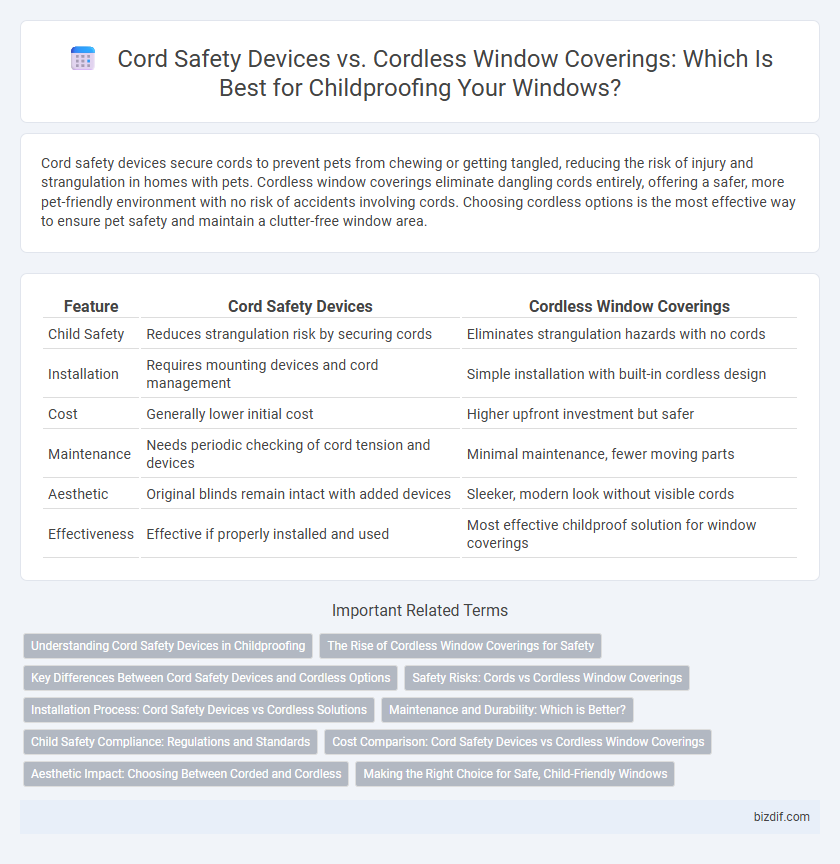Cord safety devices secure cords to prevent pets from chewing or getting tangled, reducing the risk of injury and strangulation in homes with pets. Cordless window coverings eliminate dangling cords entirely, offering a safer, more pet-friendly environment with no risk of accidents involving cords. Choosing cordless options is the most effective way to ensure pet safety and maintain a clutter-free window area.
Table of Comparison
| Feature | Cord Safety Devices | Cordless Window Coverings |
|---|---|---|
| Child Safety | Reduces strangulation risk by securing cords | Eliminates strangulation hazards with no cords |
| Installation | Requires mounting devices and cord management | Simple installation with built-in cordless design |
| Cost | Generally lower initial cost | Higher upfront investment but safer |
| Maintenance | Needs periodic checking of cord tension and devices | Minimal maintenance, fewer moving parts |
| Aesthetic | Original blinds remain intact with added devices | Sleeker, modern look without visible cords |
| Effectiveness | Effective if properly installed and used | Most effective childproof solution for window coverings |
Understanding Cord Safety Devices in Childproofing
Cord safety devices are essential components in childproofing to prevent strangulation hazards posed by window covering cords. These devices, such as cord cleats, tensioners, and cord shorteners, secure or eliminate loops and dangling cords within the reach of children, significantly reducing accident risks. Compared to cordless window coverings, which inherently eliminate cord hazards, cord safety devices offer a practical retrofit solution for existing blinds that ensures compliance with child safety standards.
The Rise of Cordless Window Coverings for Safety
Cordless window coverings have surged in popularity due to their inherent child safety benefits, eliminating the strangulation hazards posed by dangling cords. Cord safety devices, while effective in reducing risks, still rely on cords that can become loose or damaged over time, potentially compromising safety. The rise of cordless designs reflects a growing emphasis on creating safer home environments for children by removing cord-related dangers altogether.
Key Differences Between Cord Safety Devices and Cordless Options
Cord safety devices are designed to secure or shorten window covering cords, reducing the risk of strangulation by keeping cords out of children's reach. Cordless window coverings eliminate cords entirely by using spring-loaded or motorized mechanisms, offering a safer, maintenance-free alternative. Choosing cordless options ensures maximum child safety with minimal hazards, while cord safety devices provide a cost-effective solution that still requires monitoring.
Safety Risks: Cords vs Cordless Window Coverings
Cord safety devices reduce the strangulation hazard posed by window covering cords but do not eliminate the risk entirely, as cords can still become tangled or accessible to children. Cordless window coverings offer a safer alternative by removing cords altogether, significantly minimizing potential accidents and injuries in childproofed environments. Choosing cordless options aligns with modern child safety standards and enhances overall home protection.
Installation Process: Cord Safety Devices vs Cordless Solutions
Cord safety devices typically require mounting brackets or cleats installed near the window to secure and manage cords safely, which can involve drilling and precise placement to ensure effectiveness. Cordless window coverings offer a streamlined installation process with fewer components, often utilizing tension rods or spring mechanisms that fit directly inside the window frame without the need for additional hardware. Choosing cordless systems reduces installation time and complexity, while cord safety devices may demand professional installation for optimal safety compliance.
Maintenance and Durability: Which is Better?
Cordless window coverings require less maintenance due to the absence of cords that can wear or tangle, offering greater durability over time. Cord safety devices, while enhancing corded blinds' safety, involve regular checks and replacements to ensure their effectiveness. For long-term reliability and minimal upkeep, cordless window coverings are generally the superior option in childproofing window treatments.
Child Safety Compliance: Regulations and Standards
Cord safety devices and cordless window coverings are critical components in childproofing that adhere to strict safety regulations such as the U.S. Consumer Product Safety Commission (CPSC) standards. Cord safety devices must meet requirements to eliminate loop hazards, while cordless window coverings inherently reduce strangulation risks, aligning with ASTM F1918 safety standards. Choosing compliant products ensures optimal child safety and reduces liability for caregivers and manufacturers.
Cost Comparison: Cord Safety Devices vs Cordless Window Coverings
Cord safety devices offer a budget-friendly solution for childproofing existing window blinds, typically costing between $5 to $20 per device, making them an economical choice for families. Cordless window coverings, while initially more expensive with prices ranging from $50 to $300 or more per window, provide enhanced safety and a sleek, maintenance-free design. Investing in cordless options may result in long-term savings by reducing potential hazards and eliminating the need for additional safety accessories.
Aesthetic Impact: Choosing Between Corded and Cordless
Cordless window coverings offer a sleek, modern aesthetic by eliminating visible cords, creating a clean and minimalist look ideal for contemporary interiors. Cord safety devices, while ensuring childproofing by securing cords, can add bulk or visual clutter, potentially disrupting the seamless appearance of window treatments. Opting for cordless designs enhances both safety and style, aligning with trends favoring unobtrusive and elegant home environments.
Making the Right Choice for Safe, Child-Friendly Windows
Cord safety devices provide an effective barrier by securing loose cords and preventing strangulation hazards in homes with children. In contrast, cordless window coverings eliminate cords entirely, offering the safest option to reduce risks associated with window treatments. Choosing cordless designs ensures maximum child safety, while cord safety devices serve as a suitable alternative when cordless options are not feasible.
Cord safety devices vs Cordless window coverings Infographic

 bizdif.com
bizdif.com